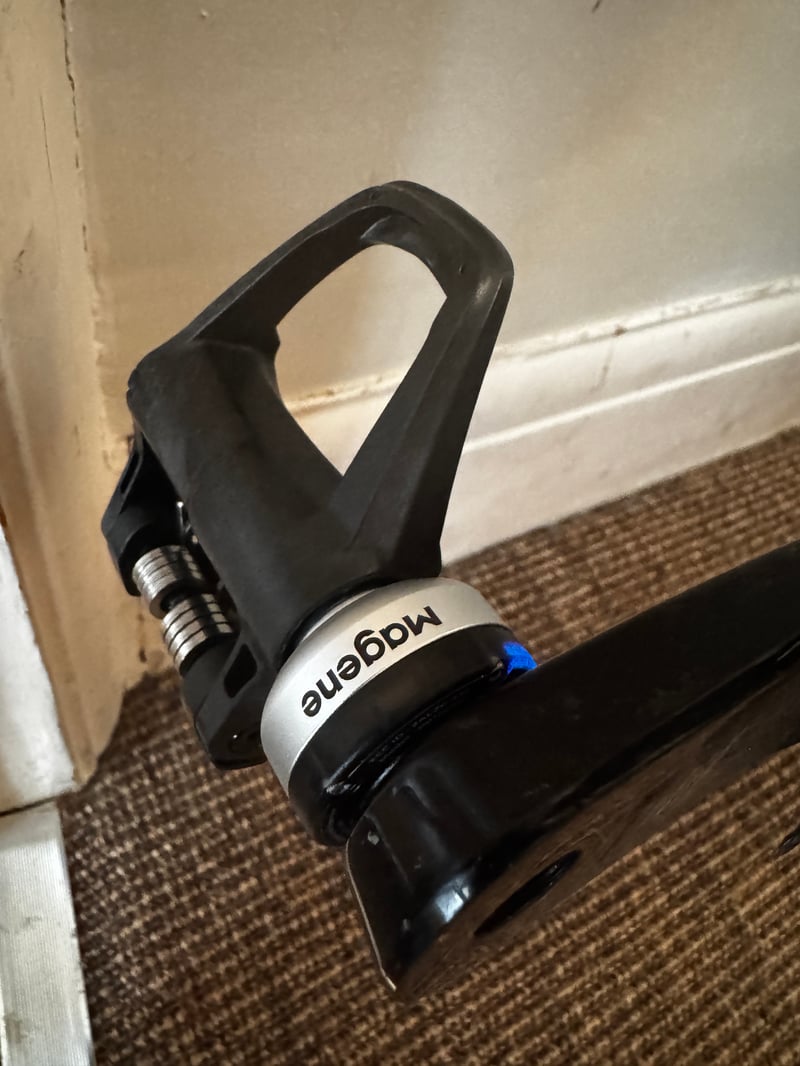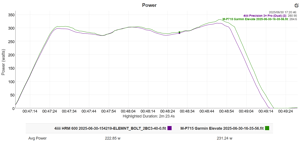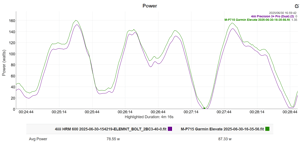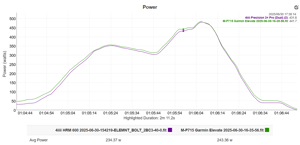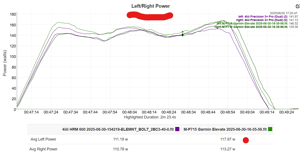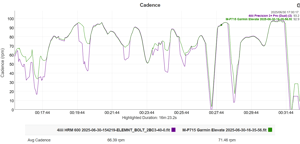Magene P715s Review – All you need to know
Magene’s latest power meter pedals are the cheapest on the market, claim +/-1% accuracy and come with a Shimano SPD-SL-compatible cleat option. I’ve had a pair for several months of use, and I’m impressed.
TL;DR – Superior price compared to the latest ASSIOMA PRO RS. Great battery life, tempered by slightly prior-gen aesthetics.
How they look
The appearance is very similar to the original Favero Assioma Duo. The issue with the Favero Assioma Duo/Uno was that the pod was slightly too big for some people. This was a slight issue rubbing against some of my cycling shoes, so I worked around with a cleat spacer. The pod on the Magene has a smaller diameter, and rubbing is not an issue.
The pod is perhaps not the prettiest thing in the world, but it looks alright. Don’t forget the pod contains that battery, which gives you the awesome battery life.
Although a DIY aftermarket solution existed, Assioma didn’t initially have an SPD-SL cleat option. Magene is starting with a Shimano option – the ‘S’ in 715s stands for Shimano. The P715 K model is KEO-cleat compatible.
Setup and first Ride
Installing onto some DuraAce cranks was easy, as I had the right-sized Allen wrench. The pods didn’t wake up from movement, so I put them on the magnetic chargers, and they came to life. The chargers snapped on very positively. First-time setup with the Magene Utility app was also pretty easy.
I prefer using a large Allen wrench for changing pedals, as it gives a secure, tight fit with minimal effort. However, the newer Assioma PRO RS opts for a more universally available spanner, which has advantages. Each approach has trade-offs. For instance, the Allen key hole Magene uses takes up internal space that could be used for electronics. This design constraint partly explains why the P715 relies on an external pod. In contrast, Assioma’s use of a spanner for tightening allows for a more compact internal layout, contributing to the pedal’s cleaner, sleeker look. It’s easier to get the required 32Nm of tightening torque with the Magene using a torque wrench than with a spanner on the Assiomas (impossible to measure with my kit).
The app isn’t as clean as Assioma’s, but it works. I updated the firmware of each pedal and set the correct crank length. I wanted to calibrate the pedals using the app just for the heck of it, and it was a good job I tried, as I discovered that the crank length hadn’t been saved for some reason. Long story short, after re-opening the app a few times, I sorted everything out.
I’ve initially only paired the P715S to my Forerunner 970. As expected, it doesn’t support a secure connection, but the pairing time did seem inordinately long, as long as a minute. Subsequent pairing as Open-BLE was very quick, but the calibration prompt didn’t always seem to materialise. The sensors ‘About’ details did not show any crank length on the FR970, nor was there any option to set the crank length.
Hmm
I checked the crank length in the app, and it was correct, so I assumed all was good.
Spinning the pedals (not the cranks). There was quite a lot of friction, and the pedals didn’t spin much, like 1-2 revolutions. However, I’m sure this was tightly packed grease in the new bearing, which will be Okay after a few rides.
Setting off for the first time, the shoes super-easily clipped in. It was so easy, almost to the point where I wasn’t sure they had engaged. That was a low default tension setting on the pedals, which I tightened for subsequent rides.
Unclipping and re-clipping were fine during the ride, and the power numbers and cadence looked superficially fine.
Subsequent Rides
It’s all bedded in after the first ride.
As expected, the pedal now spins freely, and pairing plus calibration using ANT+ is a breeze.
I tightened the cleat tension spring. Rather than my cleat popping out of the pedal almost of its own accord, a nice little twist is now needed to unclick, as you would expect.
Charging
You get one cable with a USB-A for your wall socket adapter; on the other end, it splits to the two proprietary magnetic Magene chargers. The magnet is NOT super strong, but good enough to snap on positively and hold in place whilst also being easy enough to come off if you accidentally spin the pedals. Inbuilt LEDs show the various charge states, and most modern bike head units should further warn you of a low battery state – my Wahoo Bolt 3 does.
Magene App
You probably want to update the firmware and do an initial calibration with the Magene Utility app. There’s not much to the app, and you probably won’t ever use it again.
Magene P715 Accuracy Test Results
I’ve used the P715 over the last month on two bike setups, mostly for outdoor rides and a few rides on my KICKR MOVE with MyWhoosh. The tests were between 1 and 5 hours long and included at least one other power source for comparison.
The other equipment used is Wahoo fitness KICKR MOVE, KICKR Core w/Zwift hub, Magene PES P505, and 4iiii Precision Pro 3+ (Dura Ace). Some of these have had extensive use since new and I’m now not entirely confident that they remain as accurate as they once were. All tests had each power meter calibrated at least once, including a factory spin-down calibration of KICKR MOVE.
Ride 1
Turning to the ride data on one ride versus another power meter (4iiii). The data looks alright and in the right ballpark, but some differences need further investigation – namely, LR Split, cadence, power at low levels, and power after a peak. Of course, these could quite easily be issues with the 4iiii.
Ride 2 – Indoor on MyWhoosh
This is the second portion of a longer test. Ideally, KICKR would match at least one of the other source,s but as you can see, it doesn’t.
I’ve been through all the troubleshooting with Wahoo support, and the only option is to return it, which I probably will. I’m quite happy to accept that this KICKR MOVE is not accurate any more.
Ride 3 – Outdoor ride compared to 4iiii Precision Pro 3
I’ve previously noted that the 4iii is sometimes accurate compared to other sources and sometimes not, at least at the total level. I’ve never been convinced that the LR split is correct.
Unless I have a bad pair of P715 pedals, each pedal should be equally as accurate as the same method is used to determine all metrics.
These tests show that the drive side values of both meters are closest, but that the 4iiii likely has missing cadence information, and that a 5% overall difference is more than I would expect. One of the brands is not operating within its stated performance levels.
Ride 4 – Outdoor ride compared to Magene P505 crankset
This seems like a more consistent result between the two Magene power meters.
But the difference between the two is more than I would expect from the stated performance characteristics, and the P505 does seem to underreport and miss some cadence.
Overall, the two perform in a similar way but with the crank PM missing some of the higher power levels (or the pedals overestimating them, depending on how you want to see it).
Ride 5 Second comparison to the P505
This is part of a fifth ride that pretty much confirms the results of the previous one. The 4% difference between the two sources is too much.
Ride 6 Third comparison to the P505
Same. Perhaps the left pedal has a systemic positive bias. IDK.
Ride 7 Comparison to Kickr Core in ERG mode.
Magene sits nicely in the middle of the watt range between my new KICKR Core and Zwift One (drive train fully oiled and straight to minimise drive chain loss). I don’t know which of the 3 is right!
Key Features & Highlights of the Magene P715
- Power Accuracy: Claims plus/minus 1% accuracy, consistent with industry-leading power meters.
- Battery Life & Charging: Offers a Garmin-equalling 120 hours of battery life with magnetic charging via a USB-C connector.
- Weight & Durability: Each pedal weighs approximately 157g (P715 Keo) or 159g (P715 S), with a composite body and stainless steel spindle. It might be carbon fibre. Either way, it’s light.
- Training Functions: Provides cycling data, including power, cadence, left/right balance, and potentially advanced metrics like Power Phase and Riding Position.
- Compatibility: Supports Look KEO (P715/P715K) and Shimano SPD-SL (P715S) cleat types.
- Connectivity: Utilises Bluetooth and ANT+ dual protocols for seamless device integration.
In-Depth Look at the P715’s Capabilities
The capabilities and specs are good on paper.
Power Accuracy
- Dual-sided Power Meter Spindles: Measures power from both legs with the same method for precise data.
- Embedded Gyroscope: Measures real-time angular velocity to calculate instantaneous power accurately, even with variable pedalling techniques.
- Temperature Compensation: Adjusts algorithms for consistent accuracy across varying conditions, though altitude compensation is not claimed.
Battery Life & Charging
The 120 hours matches Garmin and is more than double that of the latest Favero Assioma RS2
- 120 Hours of Cycling: Claimed battery life matches Garmin Rally RS200 and exceeds most competitors.
- Magnetic Charging: It uses a proprietary magnetic connector with a USB-C cable, which takes approximately 3 hours to charge at full charge.
Lightweight, Strong, and Safe Design
- The P715 K (Look KEO-compatible) weighs 311g per pair, and the P715 S (Shimano SPD-SL-compatible) weighs 314g per pair.
- Constructed with a composite body (likely carbon fibre, though not explicitly confirmed) and precipitation-hardening stainless steel spindle.
Advanced Training Functions
-
Basic Data: Includes power, cadence, left/right balance, pedalling smoothness, and torque effectiveness.
-
Advanced Insights:
-
- Power Phase: Measures power generation zones and force angles to optimise pedalling efficiency.
- Riding Position: Tracks power output in standing versus seated positions.
- Note: These functions are only available on compatible bike computers.
- Note: Full insights are only available when paired using ANT+.
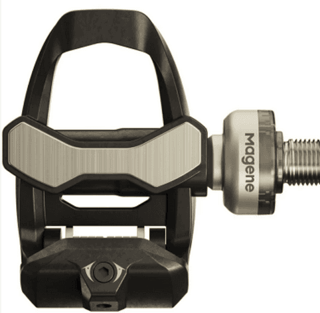
Ease of Installation and Versatility
- Installation: Advertised as a 1-minute setup using an 8mm hex wrench, similar to standard road bike pedals. I’d say it takes 2-3 minutes! Still pretty good.
- Cleat Compatibility: Supports Look KEO and Shimano SPD-SL cleats with the P715K and P715P models, respectively.
Connectivity and Calibration
- Bluetooth & ANT+: Connects to one Bluetooth device and unlimited ANT+ devices simultaneously.
- Calibration: Supports automatic and manual calibration via the Magene Utility App or compatible bike computers.
- Crank Length Adjustment: Customizable via the Magene Utility App or bike computer.
- IPX7 Waterproof: Ensures performance in wet conditions.
- Stack Height: 11mm (P715 K) and 13mm (P715 S).
- Q-Factor: 55mm for both models.
Global Pricing & Availability
- United States: $499.00, tax included, United Kingdom: £399.00, VAT included. Free shipping.
- Regional Colour Availability:
- Black model: Available outside Eu/UK
- Silver model: Available outside Germany and Italy.
- Shipping Regions: Confirmed from China to the US, UK, France, Italy, Spain, and Germany.
- Competitive Pricing: $499/£399 for dual-sided, undercutting Favero Assioma DUO ($760/£720) and Garmin Rally RS200 ($1,099/£870).
For july 2025, you might only get these directly from the brand (link below). However, PowerMeterCity has confirmed that some are on order.
Who is the Magene P715 For?
With accuracy to be confirmed, the P715 has all-around attractiveness to almost every type of rider.
- Racing/Pro Riders: Benefits from high claimed accuracy and advanced metrics for competitive training.
- Enthusiasts/Fitness Riders: Suitable for improving performance and tracking progress.
- Multi-Bike Users: Easy to transfer between bikes, ideal for riders with multiple setups.
- New Power Meter Users: Competitive pricing and robust features make it accessible for beginners.
Magene P715 vs. Competitor Products
The Magene P715 competes with leading power meter pedals like Favero Assioma RS2, Garmin Rally RS200, Wahoo Powrlink Dual, LOOK KEO Blade Power, and SRM X-Power. Below is a comparison table:
|
Feature |
Magene P715 |
Favero Assioma RS-2 |
Garmin Rally RS200 |
Wahoo Powrlink Dual |
SRM X-Power |
LOOK KEO Blade Power |
|---|---|---|---|---|---|---|
|
Power Error |
plus/minus 1% |
plus/minus 1% |
plus/minus 1% |
plus/minus 1% |
plus/minus 2% |
plus/minus 1% |
|
Battery Life |
120h |
60h |
120h |
75h |
30h |
60h |
|
Charging |
Magnetic (USB-C) |
Magnetic |
Replaceable (LR44/CR1/3N) |
Magnetic (USB-C) |
Magnetic |
Magnetic (USB) |
|
Cleat Type |
KEO & SPD-SL |
SPD-SL |
KEO, SPD-SL, SPD |
Speedplay |
SPD |
KEO |
|
Advanced Data |
Power Phase, Riding Position (Garmin-compatible) |
Basic + IAV Cycling Dynamics (Garmin-compatible) |
Basic + Cycling Dynamics |
Basic |
Basic |
Basic |
|
Weight (Pair) |
311g (K), 314g (S) |
246g |
320g |
276g |
344g |
260g |
Competitive Edge: The P715 matches Garmin Rally’s 120-hour battery life with rechargeable magnetic charging, unlike Garmin’s replaceable batteries, which I dislike. It offers advanced metrics like Power Phase and Riding Position, though these are limited to compatible devices (e.g., Garmin). Its +/-1% accuracy aligns with top competitors, and its price ($499/£399) is significantly lower than Favero Assioma DUO ($760/£720) and Garmin Rally RS200 ($1,099/£870).
My planned longer-term usage
I recently also bought the Favero Assioma Pro RS 2, intending those to be my go-to source of power for my main road bikes (Cervelo R5, S5). Now I’m not so sure that I can be bothered to swap the pedals over and may well just keep the Magene’s permanently on my R5. The point of that is not to brag about being able to have two unnecessary sets of power meter pedals, but rather that there is simply nothing wrong with the Magenes; they are fine to use as your go-to pedal.
I use my TT bike much less (Cervelo P5), so I might swap over the pedals to that when needed. However, it’s taken me years to come to the conclusion that power meters just don’t work with the oval chainrings I use. They all seem to produce incorrect data (yes, even Favero’s IAV appears wrong despite what the brand adamantly says). Recently I’d used the Assioma’s with a scaling factor (I think setting a 158mm crank rather than the actual 165 worked, I could have used a scaling factor, I know), so I could apply the same scaling factor to the PRO RS, or I could just get a spindle-based solution ie one which measure power holistically and estimates the balance (balance is unimportant). Anyway, I don’t see myself using the P715 pedals for the P5 bike.
I will probably use the P715 on my off-road bikes. On the rare occasions I use them, I tend to only do glorified trail rides that are long but not technical, so posing little risk of damage to the pedals, and if that happens…so be it. The only factor I see mitigating against that is that it’s easier to walk with SPD cleats on my MTB shoes than the SPD-SL cleats on my road shoes. Kinda bizarre that my choice of a $500 piece of electronic kit might come down to how easily I walk in the shoes it’s compatible with rather than the merits of the device itself. (I can’t justify buying PRO MX pedals for SPD cleats)
Conclusion: Compelling but…
It’s a Winner – Only if the accuracy and stats are sound
The Magene P715 combines precision, durability, and advanced features at an appealing price, making it a must-consider choice for everyone from racers to enthusiasts. Its 120-hour battery life, rechargeable magnetic charging, and support for KEO and SPD-SL cleats enhance its appeal in the key aspects where riders often express a preference.
A minor downside is the aesthetics of the pod and the slightly unusual colour of the silver version. Whilst unimportant daily, the app needs refinement as it’s the first thing a buyer experiences.
Priced at $499/£399, the P715 offers excellent value, undercutting established brands while delivering comparable (claimed) performance.
Further Info
- Magene Product Manauals
- Magene P715 Product Page
